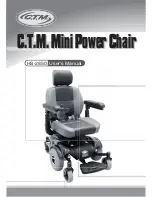
26
1. Seek confirmation from the Transporter that the vehicle is suitably designed
and equipped to transport a passenger seated in a wheelchair.
Note: The wheelchair user safety during transportation largely depends upon
the diligence of the person securing the tie downs and passenger restraints.
2. Any part of the wheelchair (accessories etc.) that can be easily detached
should be removed and stored in the vehicle luggage hold during transportation.
3. The wheelchair should always be transported in a forward facing direction.
Rearward facing is only acceptable if the occupant's head and back can be
supported by a suitable bulkhead.
4. If the wheelchair is equipped with a headrest, it should always be used
during transportation.
5. Invacare recommend that the wheelchair be secured by 4-Point webbing
tie down systems as manufactured by Unwin Safety Systems or Koller Safety
Restraint Engineers.
6. When attaching tie downs to the wheelchair it is imperative these are fixed
onto the MAINFRAME of the wheelchair and not onto any attachments or
accessories ( wheels, handrims, castors, footrests, anti tipping levers etc.)
7. The tie downs should be secured, as close as possible, at an angle of 45
degrees to ensure maximum effectiveness of the restraint in all directions.
8. The occupant should be restrained independently of the wheelchair by a
suitably Approved passenger safety belt or harness.
Pelvic restraint or lap belts supplied with the wheelchair may be used in
addition to but never as a substitute for Approved passenger restraints.
Rear Self Propel
Rear Transit
Front Castor


































